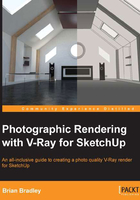
Summary
Let's quickly summarize the elements of creating a daylight solution for photographic rendering that we have covered in this chapter.
The first thing we need to keep in mind is that unless we approach every aspect of creating a photographic render with a clear, well thought out plan, there is a very good chance that we will fail to hit the required mark, whether that is one we set personally or by our client. We also need to make certain that our plan is put down as a permanent record somehow, be that written, painted, photographed, or compiled.
We also need to work smart. Rather than trying to reinvent the wheel each and every time we work on a new project, we should already have learned to work with a few tried and tested workflows that will get us most of the way towards a finished solution in a very short space of time. We also need to note that when working on lighting, every new light added to a scene should be test rendered in isolation, giving us a clear view of the illumination that particular light is adding to the environment. My preferred starting point is to have a completely dark scene into which we add and test each light.
The points we have mentioned here will become even more important as we move on to the next phase of learning to light with V-Ray, where we take a look at the options available to light a nighttime interior shot.